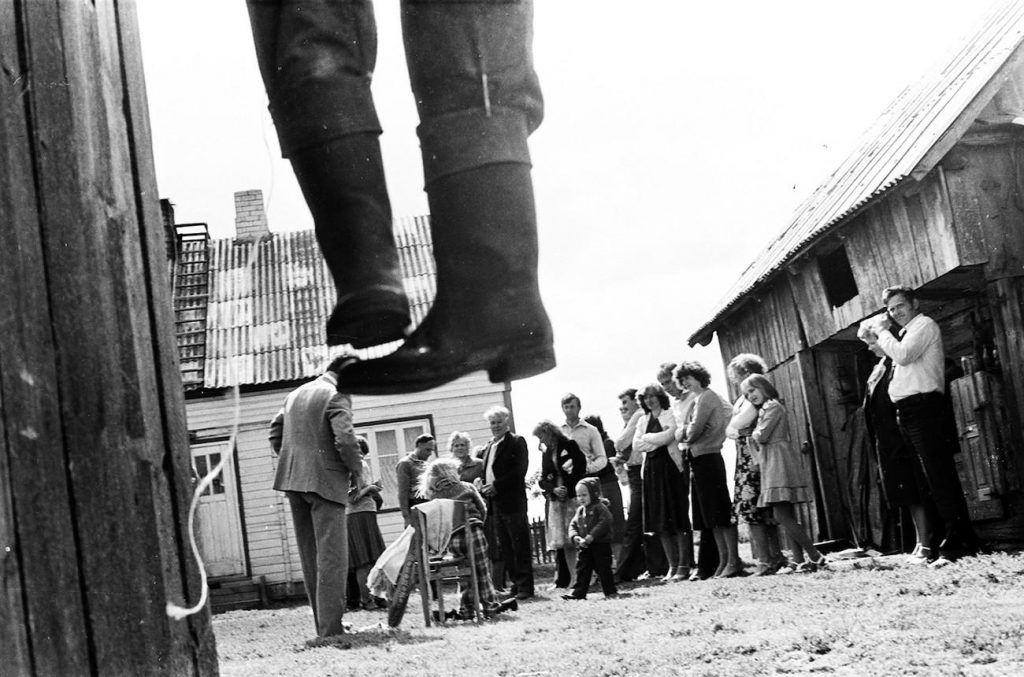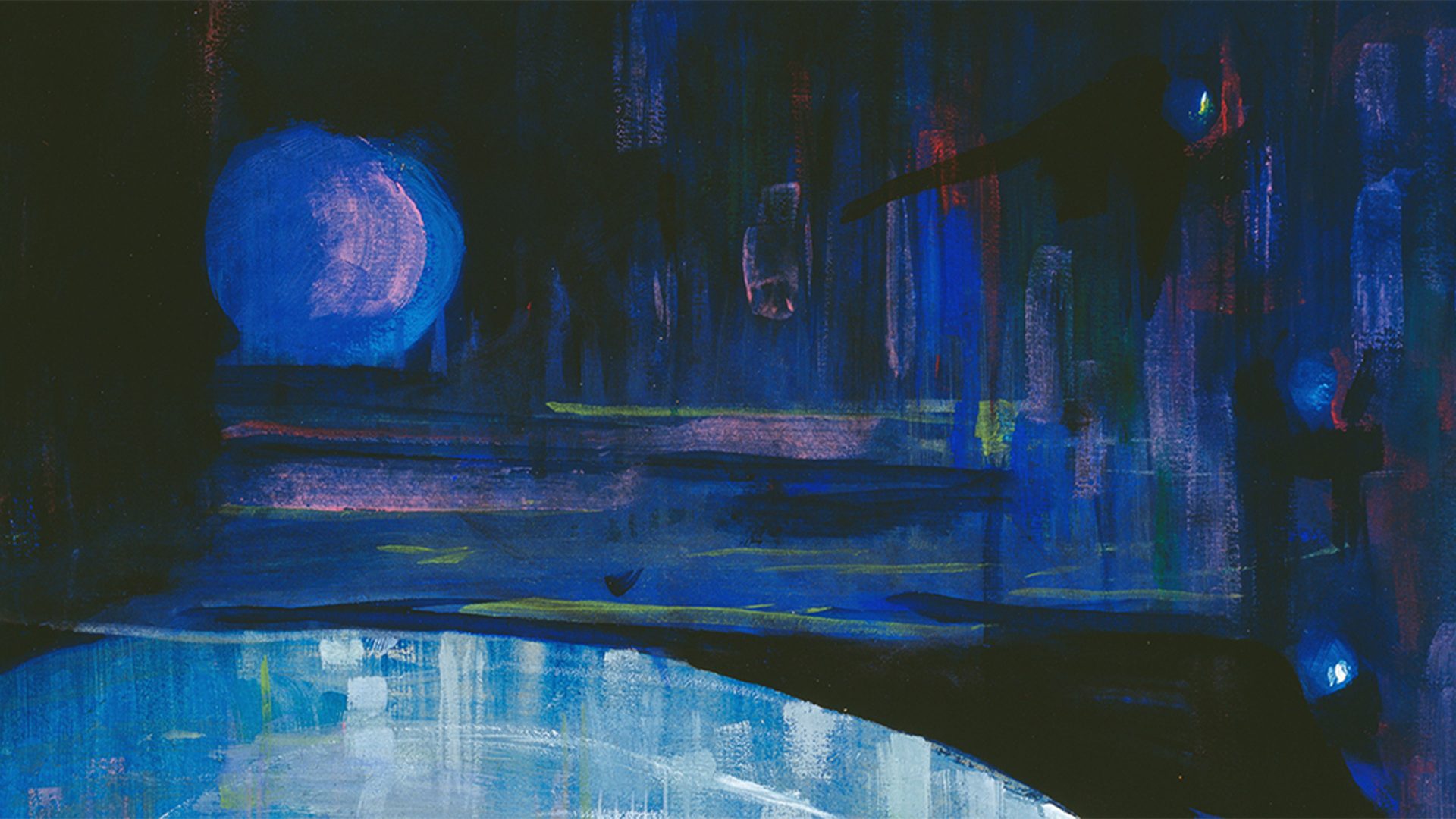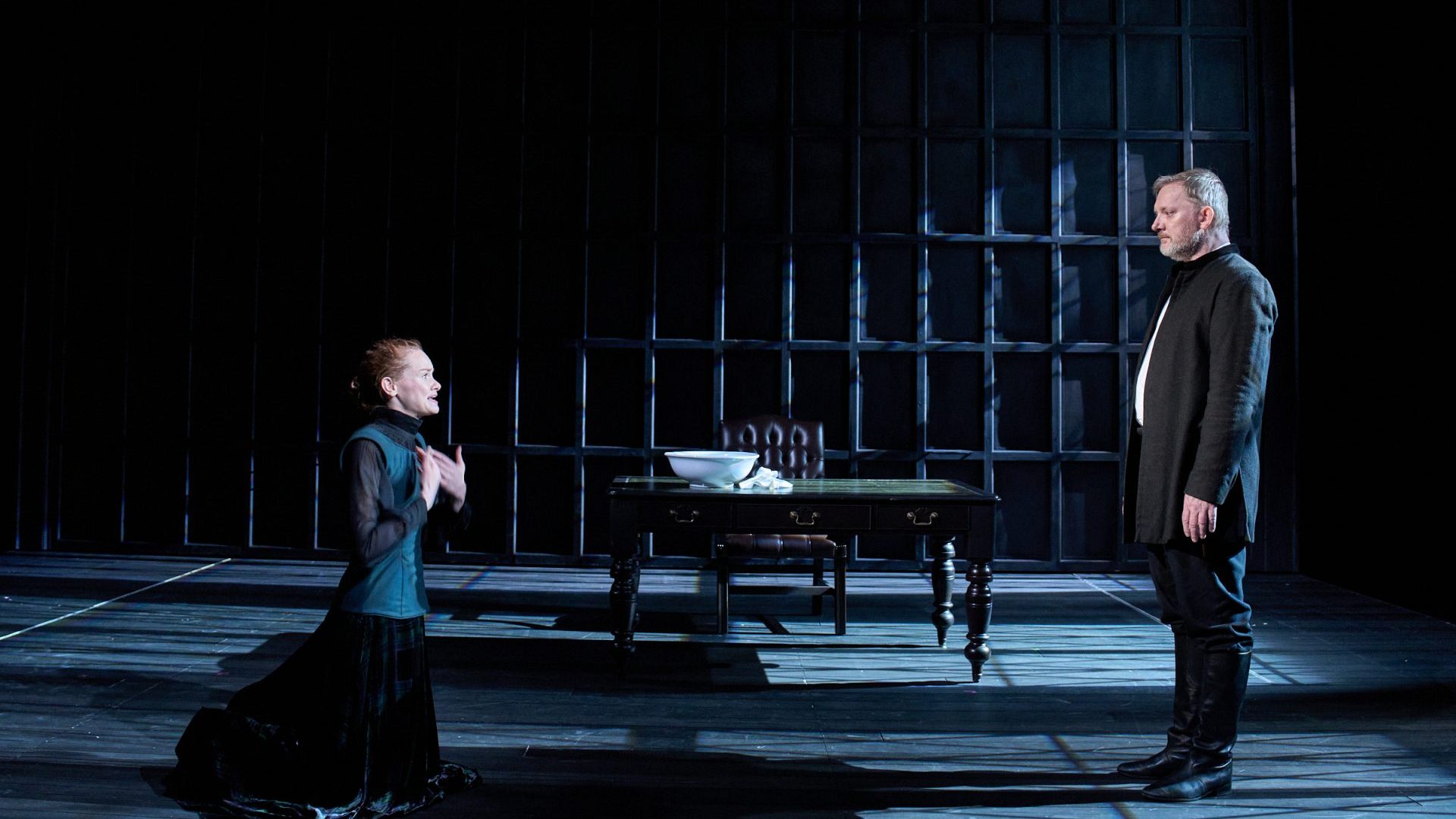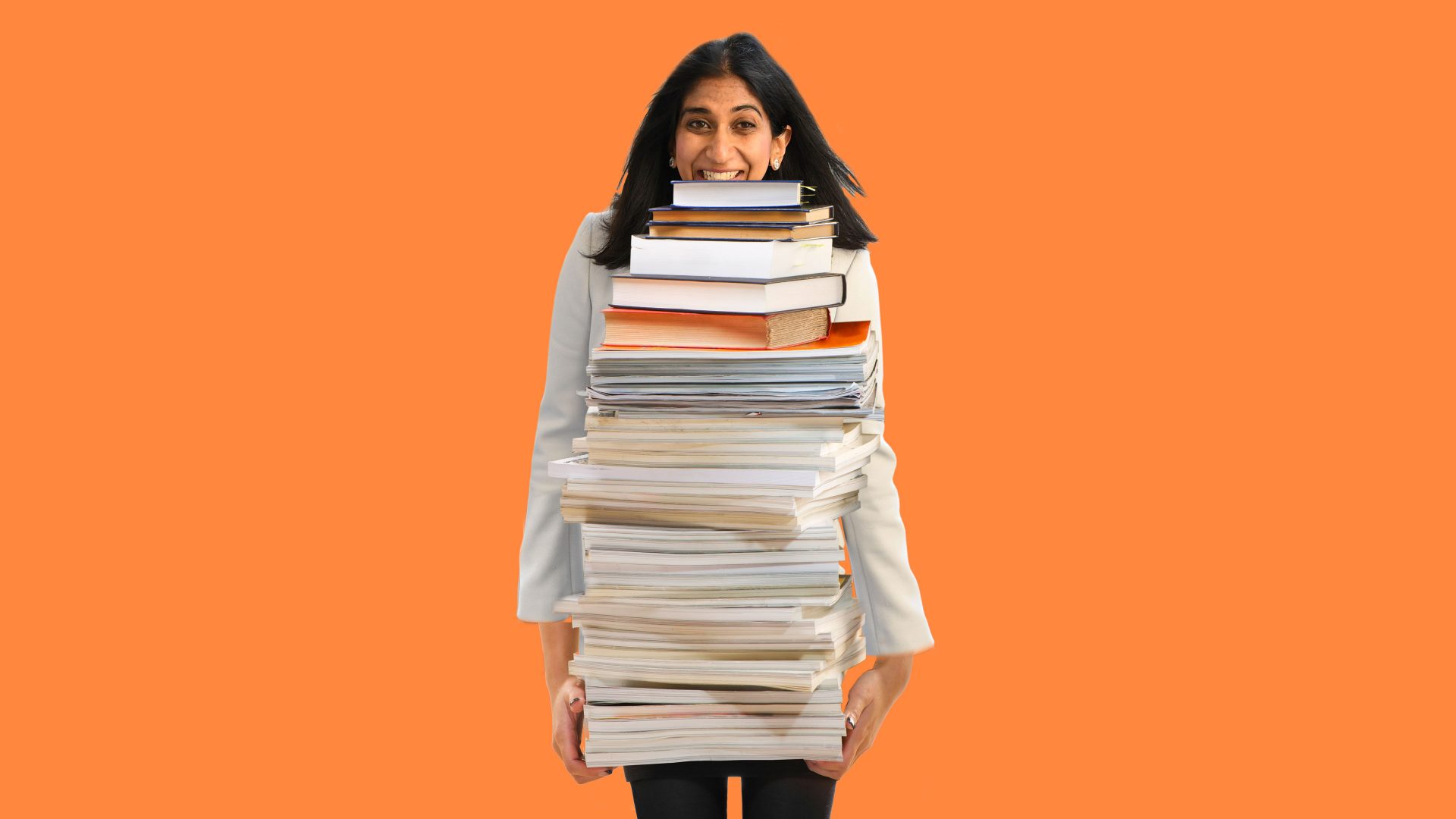Propped on the floor of a museum’s storage room, among rows of paintings in cabinets or stacked on shelves, stands a painting of a narrow corridor. There’s a door with a handle. Is it to open the door or keep it closed? What lies behind?
Out of the wall peer two eyes. No doubt what that means. Big Brother is watching you, or rather, the spy network of the Soviet machine is monitoring every citizen and, in this case, every artist.
The unsettling image, enigmatically entitled Interior (1998), is by Henrikas Natalevičius, the 69-year-old Lithuanian artist, and it reflects the suppression that artists endured under Soviet rule.
For those years Natalevičius and a clutch of his artist friends, the so-called Group of Five, along with scores of others, worked under the radar, producing work which would have been too daring and subversive to meet the regime’s claustrophobic strictures that art should follow the tenets of Socialist Realism. Painting and sculpture had to celebrate class struggle, hard labour, healthy sport and, above all, the triumph of communist values over the decadence of the west. Censorship of any deviation was instant, punishment inevitable.
Now, Interior has taken its place on the walls of the gleaming MO Museum, in Lithuania’s capital, Vilnius, for an exhibition titled The Meeting that Never Was. It brings together 45 years of cultural history from 1955 to 2000, drawn from the museum’s own 6,000 strong collection and from the Van Abbemuseum in Eindhoven, in the Netherlands. The aim is to contrast the talent, which for so many years was forced under cover, with the confident freedom of the west. It is an ambitious exhibition which enhances Lithuania’s growing stature in the world of art, as does the museum itself – a vast, multi-layered white cube designed by Daniel Libeskind, which opened in 2018.
One year later, the Lithuanian national pavilion at the 58th Venice Biennale won the Golden Lion award. This year, Lithuania’s second city, Kaunus, is the European Capital of Culture, while in October the annual art fair ArtVilnius ’22 attracted 70 galleries and 320 artists from 18 countries.
In the UK, two wildly different artists have won a wider audience for Lithuanian culture. The Dulwich Picture Gallery, in south London, has a beguiling selection of works by MK Čiurlionis (1875-1911). He may be little known in this country but he is the most significant artist in Lithuania’s cultural history with a gallery given over entirely to his works in Kaunus – and for good reason. In the true sense of the word his work is marvellous. The paintings in MK Čiurlionis: Between the Worlds present a complex world of symbols and mystical imagery inspired by myths and legends. He conjures up eastern mysticism, Egyptian pyramids, and themed paintings of Rex, a Godlike figure, the zodiac, and the seasons.
In complete contrast, Daily Rituals of Work and Play is the first major exhibition in the UK of work by the photographer Rimaldas Vikšraitis (b. 1954). His lament at the demise of traditional village life in his country is being shown at the Northern Gallery for Contemporary Art, in Sunderland.
It’s disturbing stuff. Despite some whimsical scenes of children larking about, this is a drab, depressing world, populated by the poor, who scrape a living, drink too much and seem to have lots of joyless sex. There are reminders of the deadly hand of Soviet occupation with the Hanging of the Matchmaker (1984) in which the boots of a body sway in the breeze while the crowd looks on phlegmatically.

His work, which the authorities deemed as “controversial and inconvenient”, is regularly shown at the Kaunus Photography Gallery, where many well-known local photographers, such as Aleksandras Macijauskas and Romualdas Požerskis, have also turned their lenses on an imperfect past, but with greater empathy than Vikšraitis.
Contemporary work is encouraged by the gallery. Indrė Šerpytytė, for example, photographed models of what appear to be ordinary homes and unremarkable buildings, but whose bland facades hid the fact that they were used by the KGB to terrorise their victims.
Today, in another trans-national connection, the gallery is showing the works of Dorothy Bohm who, as a girl of 14, escaped when the Nazis occupied the country in 1939. As her parents put her on a train to England, her father gave her a Leica camera which, he said, “might come in useful”. The small retrospective The Seen World is a series of sensitively composed scenes of everyday life – playgrounds, visits to the zoo and the seaside as well as travels to Paris, Lisbon and Egypt – which somehow capture the essence of the places in a single shot. Often, thanks to her subtle use of light, shade and surprising angles, her images verge on the abstract, hinting at what might be just out of sight.
Until independence, photographers had to work for the Sovietised press if they wanted to make a living, taking flattering images of the enviable Soviet lifestyle and its heroes, such as Lenin and Stalin, as well as Lithuania’s puppet hierarchy.
No wonder many artists emigrated to the west while those who stayed specialised in graphics, designing posters and book covers, working as restorers and stage designers. But all the time, they continued to create as adventurously and innovatively as they dared. But carefully. Behind closed doors.
There was no chance of public display, for as the curator Gabrielė Radzevičiūtė explains: “It would have been closed by authorities after five minutes.”
But now here they are in the MO Museum, names such as Marija Teresė Rožanskaitė, Linas Leonas Katinas, and Kazimiera Zimblytė, who are well known in Lithuania but, inevitably, lack reputations on the scale of western artists.
This is recognised by the museum’s own publicity, which stated: “The country continues to confront complexes related to self-esteem and the drive to catch up, as well as struggles over historical memory yet a real sense of adventure about their artists’ self confidence.”
Radzevičiūtė, the curator, who stresses the fact that with a population of only three million Lithuania is punching above its weight, says: “One idea that is questioned in this show is the grand narrative by western countries that these are the leading artists and the stories, and the artists who were behind the Iron Curtain do not find a place in that narrative.
“Despite the Iron Curtain, people and artists were reacting to topics, ideas, the influence of power, be it capitalist power or be it communist power, as best they could. In many ways they acted and reacted in the same way as the west, so this exhibition parallels the thinking of the artists who were subject to different ideologies and systems.”
With the fall of the Iron Curtain, artists broke free with experimental work and conceptual adventures as daring as anything in the west, using irony, wit and ridicule, not to mention outrage, at what they had endured for so many years.
One group, Post Ars (Post Art), was established in 1989 and shocked the public with its first show, featuring a composition of rotting pig heads by Česlovas Lukenskas and loaves of bread impaled with nails by Aleksas Andriuškevičius. For them, there was a lot of catching up to do.
Another significant moment came with the opening of the Contemporary Art Centre (CAC) in Vilnius in 1992, which replaced a Soviet “palace of culture”. It became a hot house for contemporary creativity with an impressive archive of the experimental Fluxus movement and its co-founder George Maciunas.
Few artists were more active in the CAC than 58-year-old Deimantas Narkevičius, who represented Lithuania at the 49th Venice Biennale in 2001 and is now staging a retrospective in the Konschthal Esch gallery, in Luxembourg.
Primarily working with film and video, one of his best known works, Once in the XX Century (2004), shows a statue of Lenin, which had been pulled down when the Soviets left, being neatly replaced back on to its plinth and into its boots, as a crowd cheers. It is counterintuitive, to say the least, but, as the artist points out, repression comes and goes in a loop. Lenin might have long gone, but when the film was made, Lithuania was in turmoil over the impeachment of a corrupt president. Now, as those same forces of destruction threaten Ukraine, the loop of repression is played again.
Like many fellow artists who forged their talents in the dark days of occupation, Narkevičius showed his work in the new galleries that burgeoned after independence, such as the Vartai gallery where he recently contributed to an auction for Ukraine. The gallery did much to nurture expressionist painting by artists such as Vilmantas Marcinkevičius, whose vigorous, almost primitive, works have been shown in art fairs across Europe. The Arka Gallery was founded by the Lithuanian Artists’ Association, a sort of union for professional artists, and more recently, since 2012, the Rupert art centre has been providing a platform for young talent.
Inevitably, they are seeking inspiration abroad, not because they were fleeing censorship like their predecessors, but because they have the freedom to participate in the same shows as their international peers.
Who is making an impact on international audiences? Augustas Serapinas, born in 1990, invites his visitors to discuss his art in a sewer in Vilnius, and he caused a stir at the 2019 Venice Biennale with his complex reworking of found objects. Patricija Jurkšaitytė (b. 1968) repaints interiors from late-Renaissance paintings but adds a mystery to what seem familiar works by removing the figures. Like many contemporary artists who have prospered abroad, Ieva Martinaitytė-Mediodia lives and works in New York and paints ethereal abstracts of space and the universe – shades of the great Ciurlionis.
Emilija Škarnulytė, won the $100,000 Future Generation Art Prize 2019 for artists under 35 from the PinchukArtCentre in Kyiv, Ukraine, for an installation that deals with ecological disaster and nuclear warfare.
Evidence of flourishing grass roots activity can be tracked down to a courtyard in the Užupis district of Vilnius, where a small collective of painters and sculptors operate. This includes Milena Grigaitiené, who highlights environmental problems with a reworking of discarded Covid masks into hearts and flowers.
The painter Eigirdas Scinskas has opened a pop-up gallery of his exuberant paintings in an abandoned shop that used to sell Armani and Gucci suits. Just down the road is the Museum of Occupations and Freedom, where the KGB conducted its reign of terror. No doubt the regime would have destroyed his work and thrown him into its filthy torture chambers. Big Brother would have been watching.
MK Čiurlionis: Between Worlds, Dulwich Picture Gallery, until March 12
Rimaldas Vikšraitis: Daily Rituals of Work and Play – The Collective Life of a Village 1975-2012, Northern Gallery for Contemporary Art, Sunderland, until January 15. The Meeting that Never Was, MO Museum, Vilnius until March 12.
Dorothy Bohm, The Seen World, Kaunas Photography Gallery until November 13.




